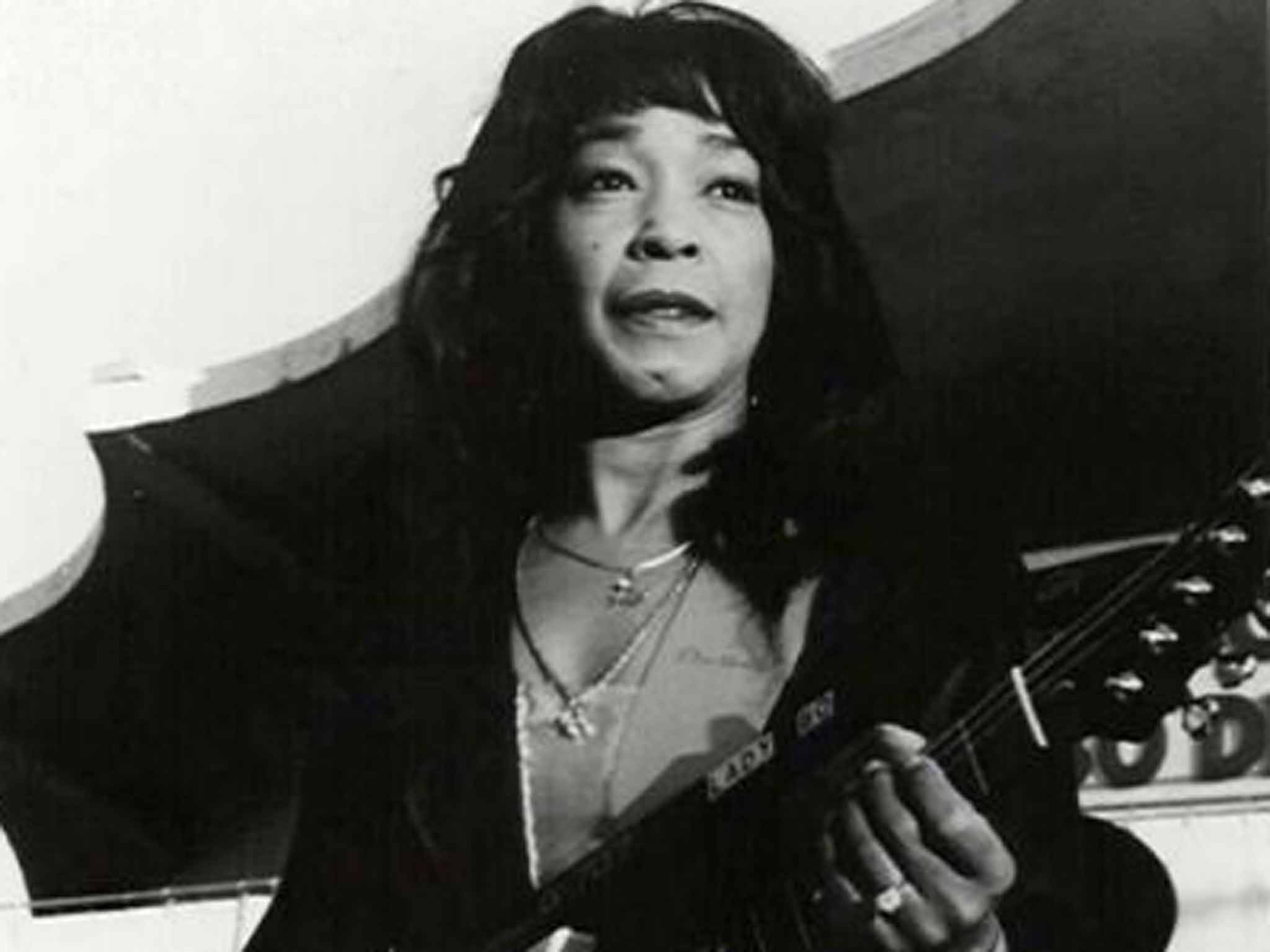Lady Bo: 'The Mother of the Electric Guitar' whose rhythm playing became a vital part of the Bo Diddley beat
Her assertiveness and take-no-prisoners attitude matched her fiery guitar playing

Known as “the Mother of the Electric Guitar”, or more famously “Lady Bo”, for her association with the legendary rock'n'roller Bo Diddley, Peggy Jones was a pioneering rhythm and blues musician who emerged in the late 1950s and remained a cult figure for the next five decades.
She followed in the footsteps of the country blues singer-songwriter Memphis Minnie and the gospel star Sister Rosetta Tharpe, two guitar-toting performers who came to prominence in the 1930s, while her career ran parallel with that of her contemporary Wanda Jackson, the rockabilly vocalist dubbed the female Elvis Presley. But Lady Bo signified a clean break with the tradition of demure female artists and paved the way for the emergence of the Cramps' guitarist Poison Ivy Rorschach in the 1970s and the Riot grrrls of the '90s.
Between 1957 and 1962 Lady Bo made significant contributions to several Bo Diddley singles, including the irresistible “Hey! Bo Diddley”, “Hush Your Mouth”, “Say Man” and “Gunslinger”, as well as the much-covered “Mona” and “Road Runner”. She was also featured on the best-selling albums Bo Diddley Is A Gunslinger (1960) and Bo Diddley (1962), which further popularised the hypnotic Bo Diddley beat after he toured the UK, and became a rich source of repertoire and inspiration for the Rolling Stones, the Yardbirds, the Pretty Things, the Kinks and the Who, and the US garage bands in thrall to the British Invasion groups. Her assertiveness and take-no-prisoners attitude matched her fiery guitar playing, still very much in evidence when she appeared at US roots and rock'n'roll revival events like the Ponderosa Stomp in recent years.
Born to musical parents in New York in 1940, she emulated her mother's singing and dancing and took up tap dancing and ballet, gaining a sense of rhythm that would be important when she joined the minimal set-up – Clifton James on drums, Jerome Green on maracas, the producer and songwriter Willie Dixon on bass – favoured by Diddley on his seminal studio recordings for the Chicago-based Chess label. A precocious child blessed with a four octave vocal range, she entered talent shows and won a scholarship to Manhattan High School for the Performing Arts. After switching from the ukulele to the guitar in 1955 she joined the doo-wop group the Bop-Chords and met Diddley backstage at the Apollo in Harlem.
Intrigued by the guitar case she was carrying, he invited her to play along with him, and was suitably impressed, not only by her feel and technique, but also by her cheek during the impromptu audition. “I listen to Wes Montgomery and Kenny Burrell and I think I heard of you,” she recalled telling her future boss, who hired her to replace Jody Williams, a stalwart of many a Chess session with Howlin' Wolf.
Bo Diddley and Lady Bo soon developed a telepathic understanding as she picked up on his distinctive open tuning. “You couldn't tell one guitar from the other, unless you were there,” she later observed about her rhythm playing and soloing which dovetailed beautifully with his strumming and riffing on his trademark rectangular red cigar box guitar. The pair became exponents of a primal antecedent of the “ancient art of weaving” subsequently favoured by Keith Richards and Ronnie Wood, the Stones guitarists and Bo Diddley aficionados, and undoubtedly made some of their best work together, including “Aztec”, the 1961 instrumental which she wrote and arranged.
The following year, she left him to concentrate on leading the Fabulous Jewels, a popular rhythm and blues band on the East Coast throughout the rest of the decade and into the 1970s. So many Bo Diddley fans inquired about Lady Bo's departure that, in her stead, the rock'n'roller recruited Norma-Jean Wofford, aka The Duchess, who backed him until 1966.
Meanwhile, Lady Bo cut several singles for MGM Records, including the Northern Soul stomper “We Got Togetherness”, and contributing percussion to the 1967 psychedelic classic “San Franciscan Nights” by Eric Burdon & the Animals. She later toured with James Brown as well as Sam & Dave and rejoined Bo Diddley in 1970. Their association continued well into the '90s and included several landmark TV appearances that introduced them to a new generation of fans in the US and beyond. A forward-looking musician, she favoured Gibson guitars but occasionally played a Roland guitar synthesiser – an unlikely choice, yet indicative of her versatility and virtuosity. She truly was a one-off.
Peggy Jones (Lady Bo), guitarist, singer, songwriter and producer: born New York 19 July 1940; married Wally Malone; died 16 September 2015.
Join our commenting forum
Join thought-provoking conversations, follow other Independent readers and see their replies
Comments